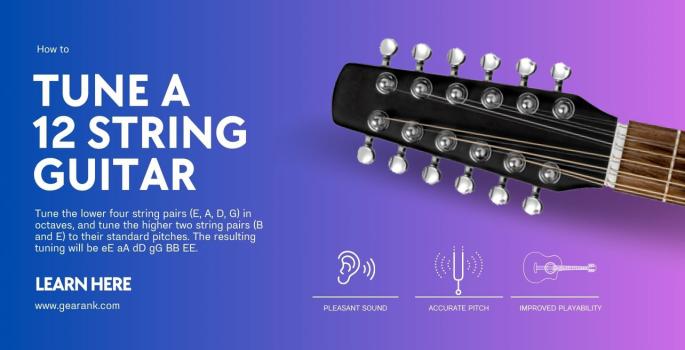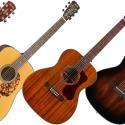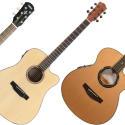How to Tune a 12 String Guitar Quickly and Easily


The extra strings of a twelve string guitar results in a full sound that you won't get from a six-string guitar. But there's a caveat, there are more strings to maintain, so you need to know how to tune a 12-string guitar.
While tuning more strings may seem complex, the process is actually very similar, and not that much harder.
Plus, there are several handy tools, such as hardware tuners or tuning apps that makes tuning quick and convenient.
In this guide, I'll de-mystify the tuning process of a 12-string guitar. I'll go over the different tunings including open, drop D, and standard tuning. And I'll explain the tuners and other relevant tools.
Standard Tuning Of A 12-String Guitar
Standard string tuning is the most common way to tune your 12-string guitar because it uses the same standard tuning technique as with other guitars.
The standard tuning of a normal guitar is E, A, D, G, B, E. And this tuning is at the core of standard 12-string tuning. To keep the tuning process simple and easy to remember, you an just group the twelve strings into 6 pairs.
Tune the lower four string pairs (E, A, D, G) in octaves, and tune the higher two (B and E) to their standard pitches. The resulting tuning will be eE aA dD gG BB EE.
Once you keep this principle in mind, 12-string tuning becomes relatively easy.
All the thicker strings need to be tuned like the usual 6-string guitar. These are E, A, D, G, B, E.
The paired strings are tuned differently depending on their position.
The lower four pairs of strings need to be tuned an octave higher relative to their pair. For example, when you take the string E, you must tune it an octave higher than the thick E string. This same octave interval applies to the A, D, and G string pair.
The high B and E pairs of thinner strings are tuned to the same pitch. This makes the thinner string pairs behave like drones and have the same thickness.
This 12-string tuning results in the characteristic jangly tone of 12-string guitars.
Here is an overview of the standard tuning for a 12-string guitar:
- e: Tune this thin string an octave higher than its corresponding thicker paired string
- E: Tune this E to the standard six-string guitar tuning
- a: Tune this thin string an octave higher than its corresponding thicker paired string
- A: Tune this A to the standard six-string guitar tuning
- d: Tune this d an octave higher than its corresponding thicker paired string
- D: Tune this D to the standard six-string guitar tuning
- g: Tune this g an octave higher than its corresponding thicker paired string
- G: Tune this G to the standard six-string guitar tuning
- B: Tune this B to the standard six-string guitar tuning
- B: Tune this B to the standard six-string guitar tuning
- E: Tune this E to the standard six-string guitar tuning
- E: Tune this E to the standard six-string guitar tuning
The lowercase letters are the strings you need to tune individually, and the uppercase letter notes must be tuned to a higher octave.
This may look difficult when you do it for the first time, but I promise it gets easier the more you tune your guitar.
Now that you know more about string pairs and individual string tuning, let's look at how you can tune your guitar with a tuner or a tuning app.
How To Tune Your 12-String Guitar With A Tuner
One of the easiest and most popular ways to tune 12-string guitars is with a tuner.
You attach these guitar tuners to your instrument, play each string individually, and tune your guitar.
Here are two types of guitar tuners I worked with and found extremely easy.
Electronic Tuners
Electronic tuners are the easiest to use, and they detect all the notes you play.
This convenience is important since you must tune twelve guitar strings, with four strings needing to be tuned an octave higher than normal tuning.
Chromatic tuners are great for this purpose. They provide a more accurate reading as you loosen or tighten your strings. This makes it easier to give your string pairs the correct pitch.
You play each string individually, and the tuner will indicate the correct note.
All you have to do then is to adjust the string tuning down or up with the tuning pegs.
Start by tuning the thicker strings to standard tuning. Then, tune their pairs accordingly.
Always keep in mind when tuning your guitar that the four lower string pairs need to be tuned an octave higher, so start tuning the thick string pairs first. Tuning the thinner paired strings is easier since they are tuned to the same note - B and E respectiviely.
You are ready to play again once your strings are properly tuned.
Automatic Tuners
Automatic tuners are mechanical tuners that can detect the pitch of your string and turn the tuning peg for you.
It's convenient to use and does all the work for you. It will automatically tune each string, provided you always have a backup battery ready.
It can significantly speed up your tuning time, and you don't have to be nervous about over-tightening and breaking your strings.
With an automatic tuner, you choose what type of tuning you want (e.g., standard, open, drop and other alternate tunings), and the tuner does the whole job.
Once you select your tuning option, you hold the tuner up to the tuning pegs, pick a string, and the tuner rotates the tuning peg automatically.
Once the tuner gives you a signal (vibration or flashing light), you can move on to the next string.
This is incredibly convenient for freshly installed strings. There is no need to tire your wrist and hands, as the automatic tuner takes away much of the hard work of tightening your strings to pitch.
Guitar Tuner Apps
Another common tuning method is using tuner apps. The majority of specific guitar tuner apps allow you to tune a variety of different guitars, including a twelve-string.
There are also tuning apps with dedicated 12-string guitar tuning mode. But a basic chromatic tuner app can also work.
The Best 12 String Guitar Tuner Apps
There is almost an endless list of string tuning apps available for tuning bass guitars, electric guitars, ukulele, and more. Some of these apps are free, while others ask you to pay a small fee for individual tuning.
For example, GuitarTuna has some great app reviews. While it is free for guitars with six strings, you must pay for the app to tune a seven or 12-string guitar.
If you plan on using your phone for tuning, then the small cost is a good investment.
What Is The Difference Between 6 And 12 String Guitar?
The apparent difference is the number of strings. And this gives the 12-string a brighter and fuller sound.
The downside to 12-string guitars is that they are harder to play.
It is a simple equation. Double the strings you need to handle also means double the fingerwork.
You'll need to fret two strings per finger. And the tricky part is fretting 12 strings to do full bar chords.
The extra strings also make it difficult to do techniques like bends, slides, hammer-ons, tapping, and others.
The difficulty difference between a six-string and a twelve-string guitar is even more substantial for beginners. But I won't stop a student who wants to enjoy the rich and jangly tone of a 12-string guitar.
Another consequence of having extra strings is needing a longer headstock to accommodate 12 tuning pegs. If you spot an acoustic guitar with a strangely long head from afar, chances are it's a 12-string guitar.
Some 12-string guitars also have wider necks to accommodate the extra strings.
From my experience, tuning is usually the last thing you think about when you decide on a guitar, but understanding how to tune your instrument is worthwhile.
This doesn't just affect how well the instrument plays and how much time you spend tuning the strings.
The basic tuning for 6-string guitars is E, A, D, G, B, and E, but you can also adapt open tunings and drop D guitar tunings to 12-string format.
In comparison, a 12-string guitar has the same strings but is doubled up, so you can vary the individual string pairs.
Drop Tuning Your 12 String Guitar
Once you know more about the standard tuning method for your 12-string, it can be great fun to try a few alternative techniques, such as drop tunings.
Although these special tuning methods are a little more challenging, they can be more rewarding. Plus, you can unlock various music styles and new songs.
Why Drop Tune A 12-String Guitar?
Unlike alternative tunings, drop tuning has several benefits when working with more strings.
Your Strings Last Longer
Your higher strings are thinner, so when you are a heavy strummer trying to produce some volume, these strings will only last for a while.
When you tune them down, you reduce the tension on the strings, giving them a slightly longer lease of life.
More Comfortable Play
There are also a few other advantages of having less tension on your strings. One of the most significant benefits is finger comfort.
With the standard tuning setup, you must pick the string much harder.
This might not sound like a big issue when you are only playing a couple of tunes, but after a 3 set gig, you start to feel the pain in your fingertips.
When you have these high-pitched strings tuned to a lower note, this takes a lot of force from the strings, making them much more comfortable to play for longer.
Plus, if your instrument feels nice, you enjoy playing and practicing more often.
Prevents Damage In Older Guitars
If you have a 12-string guitar that has seen a lot of play, the guitar body, neck, and fretboard tend to get damaged much easier.
To avoid damage to the guitar neck, tune the strings down with a semitone or to D to reduce neck tension. Then use a capo on the appropriate fret to still play first-position chords on standard tuning.
Semitone Drop For A 12-String Guitar
One of the easiest alternatives to regular guitar tuning is half step down tuning, set your instrument strings up with a full semitone drop.
This means that each string is lowered by a semitone (or half-step). This is where a chromatic tuner comes in handy because it indicates when each string reaches a semitone sharp or flat.
Generally, tuning your guitar to a semitone means you need to change the notes on the bass strings to:
- eb
- Eb
- ab
- Ab
- db
- Db
The treble strings need to be tuned to:
- gb
- Gb
- Bb (Drone)
- Bb
- Eb (Drone)
- Eb
Drop D For A 12-String Guitar
Drop-D tuning is another popular way of tuning your guitar with a chromatic tuner.
This is a popular drop-tuning method for everyone with electric guitars and rock and metal music styles.
Generally, tuning your guitar to drop d means changing the notes to dD, aA, dD, gG, BB, EE.
You can also opt for 432 Hz tuning, which lowers your pitch slightly.
Open Tuning A 12-String Guitar
Open tuning is another popular form of string tuning that you can do with 12-string guitars.
Instruments with open tuning can play minor or major chords without strings being fretted.
Open tuning in 12-string guitars is beneficial for specific music genres.
You can use an open tuning setup for 6-string guitars and apply it to the 12-string following the methods above.
Here are a few examples of my favorite 6-string open-string tunings:
- Open G: D, B, G, D, G, D
- Open C: E, C, G, C, G, C
- Open D: D, A, D, F#, A, D
- Open E: E, B, E, G#, B, E
Try some of these tunings with your 12-string guitar and hear what they sound like. Tuning variations can introduce you to music styles and melodies you'd otherwise miss out on.
Remember that you must tune the higher two string pairs the same and the lower pair string pairs an octave apart.
Note that tuning the g-string pairs can be tricky when the tuning requires them to be too slack or too tensioned.
Frequently Asked Questions
Is It Hard To Tune A 12-String Guitar?
While you have twice as many strings on a 12-string guitar as on many other guitars, tuning is relatively easy.
The first few strings are tuned to a regular 6 string guitar. And you tune the paired strings accordingly.
Can You Use A Regular Guitar Tuner For 12 String Guitars?
Yes, you can use a standard tuner for a 12-string guitar. However, a chromatic tuner allows for more accurate tuning.
Can A Beginner Play A 12-String Guitar?
If you set your mind to it and practice regularly, you can play any instrument you like.
While the 12-string guitar is naturally more complex with its additional strings, beginners already familiar with other guitars or string instruments may enjoy the challenge.
Are Chords The Same On A 12-String Guitar?
Yes, the chords and scale shapes of a 12-string guitar are precisely the same as with a standard 6-string guitar.
Final Thoughts
While 12-string guitars have double the strings of a regular guitar, they are not doubly hard to tune.
Once you know how to tune a 12-string guitar, all you have to do is memorize the standard 12-string tuning - eE aA dD gG BB EE - and use the right tools.
A good clip-on tuner is ideal, or you can use a chromatic tuner app. Whichever tuner you use, you'll be able to tune a 12-string guitar without any problems.












